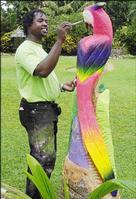
Nick applying the final touches to one of his parrots. - Ian Allen photoPROTRUDING FROM the hotel's green lawn, is a knared, brown tree stump almost four feet thick across its widest area. It is what remains of what was once a magnificent tree. Soon the stump will be a carving of the reggae idol Bob Marley.
Responsible for the promised transformation is wood carver Nick Johnson.
"The roots will be his beard. I will do three faces, each facing in a different direction. The slab a the top will become his tam," he explains.
Scattered on the lawn are other tree stumps carved into super-sized birds.
Outlook met Nick on a recent visit to Ocho Rios. The photographer, snapping away at his work, fell into an admiring frenzy, claiming that the carvings are so realistic that one might easily believe that the trees transformed into art were really birds.
Nick Johnson, now aged 30, has been carving since he was 12 years old, following a family tradition several generations old. He is one of a family of six brothers and five sisters who reside in Coconut Grove in Ocho Rios. All are skilled at producing some aspect of art and craft centred around the use of natural materials. Nick's mother and sisters weave baskets and make hampers while the brothers have their way with wood.
The carver recalls, "I just looked and learnt as an observer. Any way the wood turn, I carve it like that. I picture the idea from the shape of the wood and the stone."
We admired Nick's menagerie of birds and animals. He does what he describes as "mostly Jamaican stuff". Among his collection, one is likely to find elephants and giraffes, but it is the birds of the countryside, and particularly the parrots which fascinate him. His favourite bird is the Amazon parrot.
In Ocho Rios, there are few species of birds with which he is not familiar. There are three main species of parrots here but, the Amazon parrot is his favourite because it "speaks a lot and catches on to new phrases fast."
"Jamaican birds are more interested in relationships. They want you to tell them morning and to ask them if they are hungry," Nick says.
As we speak, he is involved in the act of reproducing the magnificent plumage of the Amazon parrot, one of many carved out of the trunk of dead or dying coconut trees on the Sandals Dunn's River property.
The artist uses acrylic paints which, according to him, performs outstandingly in local weather. Seal and lacquer used also protect the wood. "If it gets dirty one just washes it off without the need to repaint."
Of course any tree is more difficult to carve than a free-standing piece of wood, but it was a challenge which Nick accepted enthusiastically when the resident manager of the hotel, Newton Gray, suggested it to him.
Nick was a regular at the hotel, as he frequently exhibited his carvings at the Friday craft market held every week at the resort. He has been given 11 trees to do. "It takes me 10 hours to carve each one and another day to paint." He will apply three coats of paint at varying intervals.
When the project is finished, Nick will almost certainly return home to help his family. Selling carvings wholesale to vendors on Tuesdays is a family affair. The business, he says, has its ups and downs. Carving flourishes five months in the year and the rest is a recession. Now, time is spent "carving more and storing up."
The father of four children, Nick says that following in his footsteps is a daughter in primary school.
"She is doing well on the painting. She loves the primary colours. She also catches her own colours," the father says.
In the tradition of the oldest carving families, the colours used on local fauna come from leaves of the wild coco, from the bark of tree roots as well as flowers.
"The root has a high level of stain. It is boiled for at least seven hours and preserved for six weeks in hole hidden in the ground. Water is used to dilute it before use," Nick explains.
The Johnsons are fond of cedar, mahogany, and dogwood which they go searching for, buy and bring in from Portland and St. Mary. Old men in these parishes plant the trees, always replacing when one is cut down. "We plant trees too, my father and grandfather. Each generation plants for the next," Nick claims.
"The guys that burn coal are destroying lots of trees. They do not plant it back," he adds in complaint.
Nature is preserved another way by the family, as from their swiftly-moving knives emerge fish, turtles, crabs and birds.
"We have to keep the nature going," he says.
Avia Ustanny

